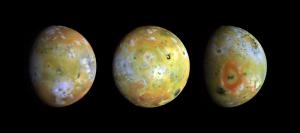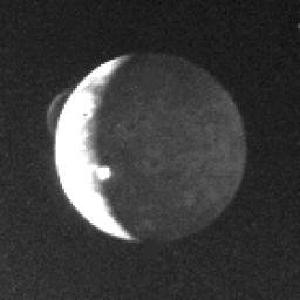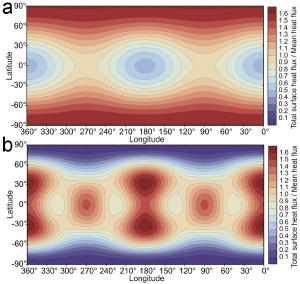Blog
Looking for Lava in
All the Wrong Places
8 April 2014
 NASA/JPL/USGS
NASA/JPL/USGSIn 1979 Linda Morabito was processing an image taken by the Voyager 1 spacecraft. It was an image of Io, one of Jupiter’s moons. She discovered what appeared to be a plume of material erupting from Io’s surface. Upon further analysis it was found to be due to a volcanic eruption, as was the first evidence of active volcanism on a body other than Earth. We now know that Io is the most geologically active body in our solar system.
 NASA
NASAIo is so geologically active because of the gravitational interactions it experiences between Jupiter and other moons. Because Io’s orbit is in resonance with Europa and Ganymede, its orbit is kept a bit elliptical. This means that it oscillates between being a bit closer and farther away from Jupiter. As a result the tidal forces of Jupiter squeeze and stretch Io, kind of like squeezing putty in your hand. This doesn’t deform Io’s shape that much, but just like squeezing putty makes it warm, squeezing Io keeps its interior warm.
This source of heat is very different the source that drives Earth’s geologic activity, which is radioactive decay and the remnant heat of Earth’s formation. Because Io is continuously driven by tidal forces it is much more active. Io erupts about 100 times more lava than Earth, and Io’s lava is much hotter than Earth’s. No impact craters have been observed on Io, which means volcanic activity likely resurfaces the moon within less than a million years.
 NASA/Christopher Hamilton
NASA/Christopher HamiltonBottom: Prediction for asthenosphere heating.
About 100 active volcanos have been observed on Io, which is enough to study the way in which the tidal forces heat the moon. There are two basic models for Io’s tidal heating. One is that the heating primarily occurs in the core, while the other is that it occurs closer to the surface, in a layer under the crust known as the asthenosphere. If the core is the source of heat, then most of the volcanic activity should occur in the polar region, but if the asthenosphere is the source of heat, then Io should be more active in the equatorial regions. A recent paper in Earth and Planetary Science Letters found that volcanic activity tends to be more equatorial, which indicates that the asthenosphere is the source of Io’s volcanism.1
But the authors also discovered that volcanic activity didn’t cluster in the equatorial regions that tidal models predict. They were shifted along the equator about 30 – 60 degrees east of the predicted model. Just why that would be the case isn’t clear. So while the asthenosphere model works in a general sense, there are aspects of Io’s volcanism we still don’t understand.
Hamilton, Christopher W., et al. “Spatial distribution of volcanoes on Io: Implications for tidal heating and magma ascent.” Earth and Planetary Science Letters 361 (2013): 272-286. ↩︎